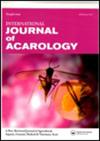Acaricidal efficacy of bitter almond against two tick species, Argas persicus and Haemaphysalis darjeeling – an in vitro study
IF 1
3区 农林科学
Q3 ENTOMOLOGY
引用次数: 0
Abstract
ABSTRACT Use of plant extracts as acaricides for controlling ticks is an essential area of research concerning economic security and environmental health. The aim of this study was to focus on the acaricidal efficacy of bitter almond powder and bitter almond extracts (aqueous and alcoholic) against the nymph and adult stages of two tick species. It was evaluated at five different concentrations (1% to 5%) with bitter almond powder, bitter almond extracts, and alpha-cypermethrin (1 ml/100 ml) at four different exposure times (24, 48, 72, and 96 hours). The effectiveness of bitter almond alcoholic extract was significantly higher than the aqueous extract, and effectiveness was lowest with the powder at all concentrations at different exposure times for both species. Furthermore, aqueous and alcoholic extracts showed a higher mortality rate among both species than alpha-cypermethrin. LC50 value showed that the toxicity level of bitter almond acaricides increased with the longer exposure time and higher concentration. Toxicity level decreased in the order of alcoholic > aqueous > powder on both species. For both species, the highest toxicity level of bitter almond alcoholic extract was shown for the adult than nymph. Therefore, extracts of bitter almond can be used as an excellent acaricidal alternative to alpha-cypermethrin against these two species.苦杏仁对桃灰蜱和大吉岭血蜱的体外杀螨效果研究
摘要利用植物提取物作为杀螨剂防治蜱虫是经济安全和环境健康研究的一个重要领域。本研究的目的是集中研究苦杏仁粉和苦杏仁提取物(水性和酒精性)对两种蜱虫若虫和成虫期的杀螨效果。在四个不同的暴露时间(24、48、72和96小时),用苦杏仁粉、苦杏仁提取物和α-氯氰菊酯(1ml/100ml)在五种不同浓度(1%至5%)下对其进行评估。苦杏仁醇提取物的有效性显著高于水提取物,在不同暴露时间下,粉末的有效性最低。此外,水提取物和酒精提取物在这两个物种中的死亡率都高于氯氰菊酯。LC50值表明,苦杏仁杀螨剂的毒性水平随着暴露时间的延长和浓度的增加而增加。毒性水平下降的顺序为酒精>水>粉末。对于这两个物种,苦杏仁醇提取物对成虫的毒性水平高于若虫。因此,苦杏仁提取物可作为高效氯氰菊酯的优良杀螨替代品。
本文章由计算机程序翻译,如有差异,请以英文原文为准。
求助全文
约1分钟内获得全文
求助全文
来源期刊
CiteScore
2.20
自引率
9.10%
发文量
60
审稿时长
6-12 weeks
期刊介绍:
The International Journal of Acarology has a global readership and publishes original research and review papers on a wide variety of acarological subjects including:
• mite and tick behavior
• biochemistry
• biology
• control
• ecology
• evolution
• morphology
• physiology
• systematics
• taxonomy (single species descriptions are discouraged unless accompanied by additional new information on ecology, biology, systematics, etc.)
All submitted manuscripts are subject to initial appraisal by the Editor. If the English is not of a quality suitable for reviewers, the manuscript will be returned. If found suitable for further consideration, it will be submitted to peer review by independent, anonymous expert referees. All peer review is single blind.

 求助内容:
求助内容: 应助结果提醒方式:
应助结果提醒方式:


